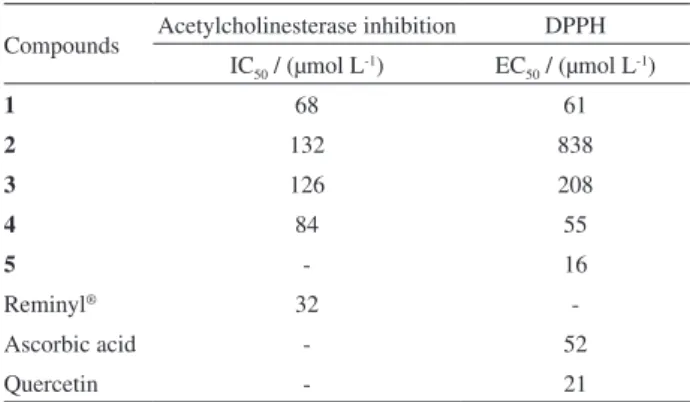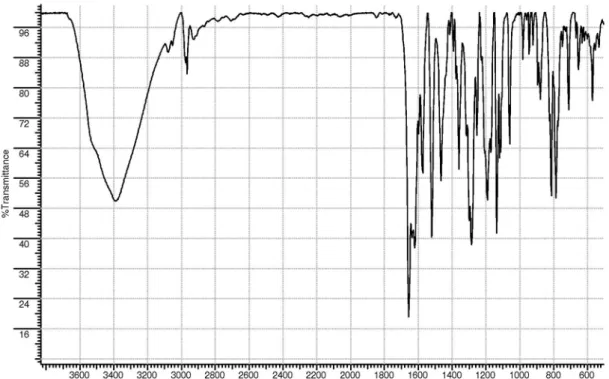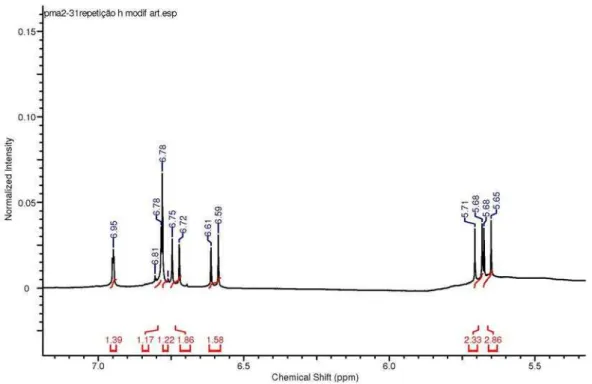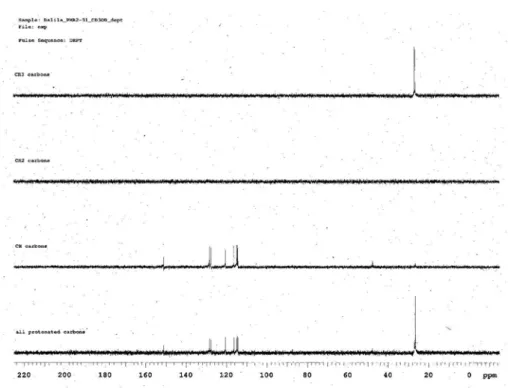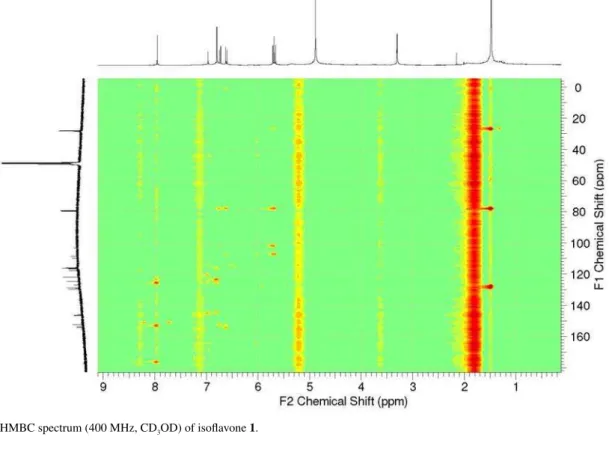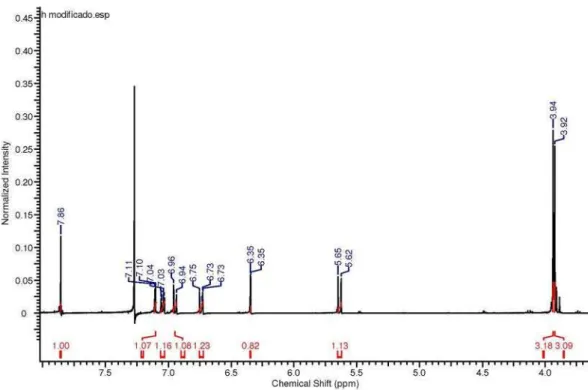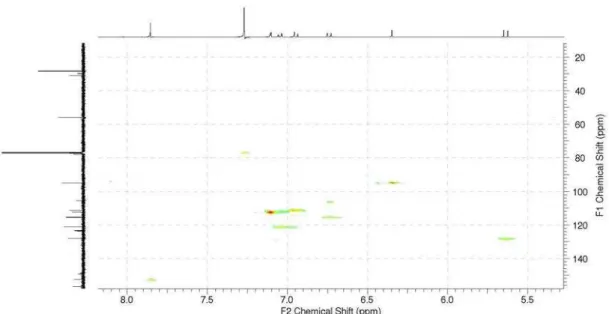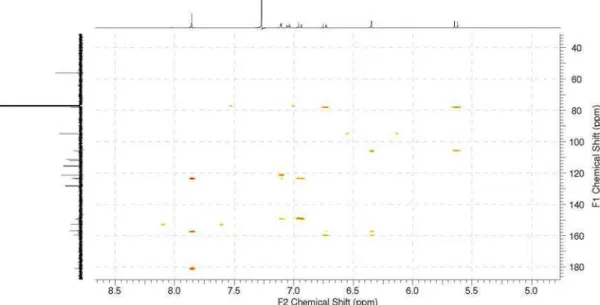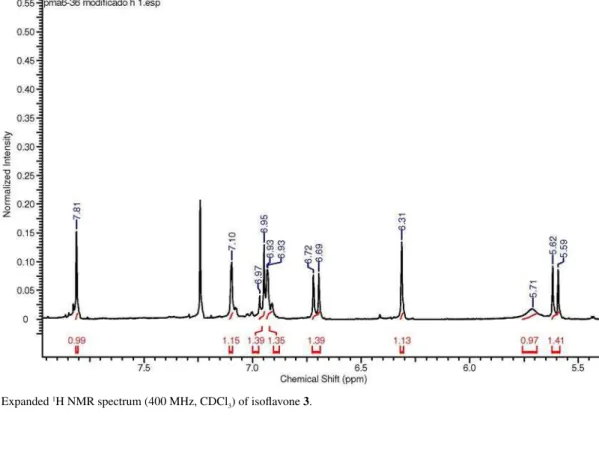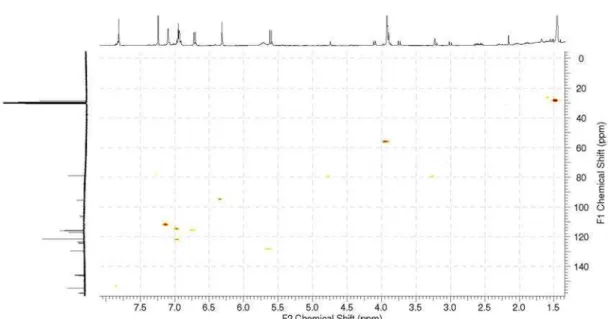Article
J. Braz. Chem. Soc., Vol. 24, No. 12, 1991-1997, 2013. Printed in Brazil - ©2013 Sociedade Brasileira de Química
0103 - 5053 $6.00+0.00
A
http://dx.doi.org/10.5935/0103-5053.20130249*e-mail: moacir.pizzolatti@ufsc.br
PAMPA Permeability, Acetylcholinesterase Inhibition and Antioxidant Activity of
Pyranoisoflavones from
Polygala molluginifolia
(Polygalaceae)
Dalila Venzke,a Francieli K. Carvalho,a Ana P. Ruani,a Aldo S. Oliveira,a Inês M. C. Brighente,a
Gustavo A. Micke,a Anderson Barisonb and Moacir G. Pizzolatti*,a
aDepartamento de Química, Centro de Ciências Físicas e Matemáticas, Universidade Federal de Santa Catarina, Campus Universitário, Trindade, 88040-900 Florianópolis-SC, Brazil
bDepartamento de Química, Centro Politécnico, Universidade Federal do Paraná, 81530-900 Curitiba-PR, Brazil
Uma investigação fitoquímica de Polygala molluginifolia (raiz, caule, folhas e flores) resultou no isolamento de quatro piranoisoflavonas das quais a isoflavona 1 é desconhecida na literatura. As isoflavonas 2-4, embora sejam compostos sintéticos conhecidos são descritos neste trabalho como novos produtos naturais. Os compostos isolados foram avaliados em termos do seu efeito antioxidante e o potencial para inibir a enzima acetilcolinesterase. As isoflavonas 1 e 4 inibiram a acetilcolinesterase, exibindo valores de IC50 de 68 µmol L
-1 e 84 µmol L-1, respectivamente. No ensaio de DPPH, os mesmos compostos e a rutina 5 apresentaram valores de EC50 de 61 µmol L
-1, 55 µmol L-1 e 16 µmol L-1, respectivamente. Além disso, a permeabilidade das compostos 1-4 foi testada através do ensaio de permeabilidade em membrana artificial paralela (PAMPA) com as isoflavona 3 (9.25 × 10-6 cm s-1) e 4 (3.48 × 10-6 cm s-1) exibindo as maiores permeabilidades.
A phytochemical investigation of Polygala molluginifolia (root, stem, leaves and flowers) resulted in the isolation of four pyranoisoflavones, of which isoflavone 1 was previously unknown in the literature. Isoflavones 2-4, although they are known synthetic compounds, are described in this work as new natural products. The isolated compounds were evaluated for their antioxidant effects and potential for inhibiting the acetylcholinesterase enzyme. Isoflavones 1 and 4 inhibited acetylcholinesterase, displaying IC50 values of 68 µmol L
-1 and 84 µmol L-1, respectively. In the DPPH assay, the same compounds and rutin 5 exhibited EC50 values of 61 µmol L
-1, 55 µmol L-1 and 16 µmol L-1, respectively. Moreover, the permeability of compounds 1-4 was evaluated using parallel artificial membrane permeability assay (PAMPA) with isoflavones 3 (9.25 × 10-6 cm s-1) and 4 (3.48 × 10-6 cm s-1) exhibiting the highest permeabilities.
Keywords:Polygalaceae, Polygala molluginifolia, isoflavones, in vitro assays
Introduction
In the course of our research on the chemotaxonomy and biological activity of the genus Polygala, we investigated
P. molluginifolia (A. St.-Hil.), a small herb found in grassland formations along the Atlantic Forest of southern Brazil.1 No
previous investigations have been reported regarding this species. The genus Polygala has been chemotaxonomically characterized by an accumulation of xanthones,2,3
coumarins,4 saponins,5,6 flavonoids,7,8 lignans,9 and more
rarely, isoflavones.10 In our previous studies, we detected
an unusual occurrence of styrylpyrones in P. sabulosa.11
T h e Po l y g a l a s p e c i e s h a v e s i g n i f i c a n t ethnopharmacological value. For example, P. cyparissias
is used as a local anesthetic due to the presence of methyl salicylate in its roots,12,13 and P. tenuifolia is used in
traditional Chinese medicine to improve memory and intelligence.14 Biological studies have reported that
P. tenuifolia is utilized in the treatment of Alzheimer’s disease,15 and also applied as an expectorant and sedative.16
P. caudate is widely employed for treating cough and hepatitis and is used as a sedative.17 Moreover, P. radix
exhibits neuroprotective effects in Parkinson’s patients,18
and P. japonica demonstrates anti-inflammatory activity.19
Our pharmacological studies indicated that P. paniculata
PAMPA Permeability, Acetylcholinesterase Inhibition and Antioxidant Activity of Pyranoisoflavones J. Braz. Chem. Soc.
1992
exhibits anti-depressant, anxiolytic and anti-convulsant activity.21 We now report the isolation and structural
elucidation of four isoflavones from P. molluginifolia, their antioxidant activity, acetylcholinesterase inhibition and PAMPA (parallel artificial membrane permeability assay) permeability.
Experimental
General experimental procedures
Melting points were determined on a Microquímica APF-302 apparatus and are uncorrected. The infrared (IR) spectral data were acquired using Perkin-Elmer FT 16PC and Varian 3100 FT-IR instruments with KBr disks. UV spectra was measured with a Hewlett Packard 8452A instrument. The 1D and 2D nuclear magnetic resonance (NMR) data were acquired on a Varian Unity plus NMR spectrometer operating at 9.4 Tesla, observing 1H and 13C at
400 and 100 MHz, respectively. Thin-layer chromatography was performed on a pre-coated silica gel type-60 plate (Merck), and the spots were located by spraying with sulfuric-anisaldehyde followed by heating. For the standard chromatographic fractionation, 70-230-mesh silica gel was used, and for flash chromatographic fractionation, 230-400-mesh silica gel was employed. The electrospray ionization quadrupole time-of-flight mass spectrometry (ESI-Q-TOFMS) measurements were performed with a micrOTOF Q-II (Bruker Daltonics) mass spectrometer equipped with a KD Scientific automatic syringe pump for sample injection. The ESI-QTOF mass spectrometer was run at 4.5 kV and a desolvation temperature of 180 °C. The mass spectrometer was operated in the positive ion mode using a standard electrospray ion (ESI) source to generate the ions. The samples were injected using a constant flow rate (3 µL min-1), and the solvent was an acetonitrile/
methanol mixture. The ESI-Q-TOF MS instrument was calibrated in the m/z 50-3000 range using an internal calibration standard (low concentration tuning mix solution) supplied by Agilent Technologies. The data were processed using Bruker data analysis software version 4.0. The acetylcholinesterase was measured using acetylthiocholine iodide (ATCI), 5,5′-dithiobis-[2-nitrobenzoic acid] (DTNB), acetylcholinesterase (AChE) type VI-S from an electric eel, [tris(hydroxymethyl)aminomethane] Tris-HCl buffer, bovine serum albumin (BSA) and magnesium chloride hexahydrate supplied by Sigma Aldrich (USA). For the 2,2-diphenyl-1-picrylhydrazyl (DPPH) analysis, DPPH (Sigma Aldrich), methanol (Vetec) and ethanol (Synth) were used. The bioassays were performed on a Perkin Elmer Lambda S spectrophotometer. High-performance
liquid chromatography (HPLC)-grade acetonitrile was purchased from J. T. Baker, and Milli-Q pure water was obtained from a Milli-Q Plus ultra-pure water purification system purchased from Millipore. The PAMPA experiments were performed using phosphatidylcholine, dimethyl sulfoxide and dodecane purchased from Sigma Aldrich and multiscreen filter plates from Millipore. The donors, acceptors and equilibrium solutions were analyzed using a Shimadzu HPLC system equipped with an LC-10AT pump and a UV detector. The analysis was performed on a Phenomenex C18 column (150 × 4.6 mm; 5 µm), and
elutions were obtained in isocratic mode [25% H2O (v/v)
and 75% acetonitrile (v/v)] at a flow rate of 1 mL min-1,
with detection at 280 nm.
Plant material
Polygala molluginifolia was collected in December, 2010, near the Pitangui River, at coordinates UTM 593095 and 7231847, in the region of Campos Gerais, Ponta Grossa, Paraná State, Brazil. The species was identified by Raquel Lüdtke (UFPel), and a sample specimen was deposited at the FLOR Herbarium (UFSC) registered under number 39551 by Rafael Trevisan.
Extraction and isolation
The dried whole-plant material (37.0 g) was extracted (three times for seven days each) with EtOH at room temperature. The resulting extracts were combined, filtered and concentrated under reduced pressure at 50 °C to yield the crude alcoholic extract (10.45 g), which was then solid-liquid partitioned with hexane and EtOAc, and the solvents removed under reduced pressure to yield the respective extracts. The residue from the extraction was denominated water-soluble fraction. The EtOAc-soluble fraction (3.66 g) underwent chromatographic fractionation on a silica gel column and eluted with a gradient of EtOAc in hexane (1:9, 2:8, 3:7, 4:6, 5:5, 7:3), and then a gradient of EtOH in EtOAc (2:8, 4:6), to yield 41 fractions. Fraction 6 (1:9 EtOAc-hexane) underwent a successive chromatographic fractionation on a flash silica gel column and eluted with a hexane:acetone 8:2 gradient to yield isoflavones 2 (7.2 mg) and 3 (11.7 mg). Fractions 19 (3:7 EtOAc-hexane) and 31 (EtOAc) were recrystallized with MeOH to yield compounds 4 (16.4 mg) and 1 (38.7 mg).
Venzke et al. 1993 Vol. 24, No. 12, 2013
(1:19:13, hexane:EtOAc:EtOH) were combined to generate compound 5. Fraction 28 (methanol) was recrystallized with MeOH to yield compound 6.
3′,4′-dihydroxy-6″,6″,6″′,6″′-tetramethylbis(pyrano
[2″,3″:5,6::2″′,3″′:7,8]isoflavone (1)
Yellow solid; mp 205–207 °C; IR (KBr) υmax / cm-1
3416, 1654, 1595, 1507, 1452; UV (MeOH) λmax / nm
(ε) 340 (2265), 302 (25604), 292 (25335), 258 (24798); for NMR data, see Table 1; HRMS (ESI+) m/z calculated for C25H22O6 [M+H]+: 419.1495; found, 419.1495.
3′,4′-dimethoxy-5-hydroxy-6″,6″-dimethylpyrano[2″,3″:7,6] isoflavone (2)
Yellow solid; mp 136–138 °C; IR (KBr) υmax / cm-1
3434, 1665, 1622, 1583, 1509; for NMR data, see Table 2; HRMS (ESI+) m/z calculated for C22H20O6 [M+H]+:
381.1338; found, 381.1328.
3′-methoxy-5,4′-dihydroxy-6″,6″-dimethylpyrano[2″,3″:7,6] isoflavone (3)
Yellow solid; mp 155-158 °C; IR (KBr) υmax / cm -1 3434,
1662, 1624, 1581, 1516; for NMR data, see Table 2; HRMS (ESI+) m/z calculated for C21H18O6 [M+H]
+: 367.1182;
found, 367.1179.
5,3′,4′-trihydroxy-6″,6″-dimethylpyrano [2″,3″:7,6]isoflavone (4)
Yellow solid; mp 165–167 °C; IR (KBr) υmax / cm-1
3386, 1656, 1621, 1573, 1519; for NMR data, see Table 2; HRMS (ESI+) m/z calculated for C20H16O6 [M+H]+:
353.1025; found, 353.1022.
Acetylcholinesterase activity
The enzymatic activity was measured using an adaptation of the method described by Mata et al.22 Briefly,
325 µL of 50 mmol L-1 Tris-HCl buffer, pH 8.0, 100 µL
of a buffer solution containing the sample at five different concentrations dissolved in EtOH and 25 µL of an AChE solution containing 0.28 U mL-1 (50 mmol L-1 Tris-HCl,
pH 8.0 buffer, 0.1% BSA) were incubated for 15 min. Then, 75 µL of an acetylthiocholine iodide solution (0.023 mg mL-1
in water) and 475 µL DTNB (3 mmol L-1 in Tris-HCl, pH 8.0
buffer, 0.1 mol L-1 NaCl, 0.02 mol L-1 MgCl
2) were added,
and the final mixture was incubated for another 30 min at room temperature. The absorbance of the mixture was measured at 405 nm. A control mixture containing ethanol instead of the sample was considered to have 100% AChE activity. The inhibition (%) was calculated as follows: I (%) = 100 – (Asample/Acontrol) × 100 in which Asample is the
absorbance of thevegetal sample and Acontrol is the absorbance
without sample. The tests were performed in triplicate, and a blank containing Tris-HCl buffer was used instead of the enzyme solution. The sample concentration with 50% inhibition (IC50) was determined by plotting the inhibition
against the sample solution concentrations. Reminyl-containing galantamine was used as the positive control.
Antioxidant activity
The antioxidant activity was measured using the DPPH free-radical scavenging methodology described in the literature with adaptations.23 A 0.004% DPPH solution
in methanol was added to the test solutions in various concentrations, and the absorbances were determined using a UV-VIS (517 nm) spectrophotometer after 30 min. The absorbance at the initial time (A0) was obtained by
measuring the absorbance of a DPPH solution. The analysis was performed in triplicate. The EC50 values of the samples
were obtained by plotting the decreasing DPPH absorbance against the sample solution concentrations.
PAMPA permeability assay
PAMPA experiments for compounds 1-4 were performed according to Wohnsland and Faller with modifications using a 96-well filter plate.24 The filters were coated with 10 µL
of a 1% (m/v) dodecane solution of phosphatidylcholine. The donor solutions of compounds 1-4 were prepared by diluting the DMSO stock solutions (1000 ppm) in 50% (v/v) phosphate buffered saline and stirring overnight. Then, 150 µL of the donor solutions were added to the filter plate wells, and 300 µL of the acceptor solutions (50% DMSO in phosphate buffer) were added to the receiver plate wells. The filter plate was coupled to the receiver plate and incubated in the dark for 5 h with agitation and then 20 min at room temperature. Next, 150 µL of each donor solution was added to 300 µL of the acceptor solution to yield the respective equilibrium solutions. The experiments were performed in quadruplicate. After incubation, the filter plate and the receiver plate were separated, and the donor, acceptor and equilibrium solutions were analyzed via HPLC.
The PAMPA permeability (Papp) was calculated using the following equation obtained from Wohnsland and Faller:24
in which VD is the volume in the donor well (cm3), V A is the
PAMPA Permeability, Acetylcholinesterase Inhibition and Antioxidant Activity of Pyranoisoflavones J. Braz. Chem. Soc.
1994
(cm2), t is the incubation time (s) and r is the ratio between
the compound concentrations in the acceptor well and equilibrium solution. The compound concentrations were obtained by integrating the HPLC peaks.
Results and Discussion
In our investigation of the ethyl acetate fraction from
Polygala molluginifolia, four isoflavones (1-4) were isolated and their structures elucidated. In addition, rutin (5) and sucrose (6) were isolated from the water-soluble fraction (Figure 1).
The infrared spectra of compounds 1-4 demonstrated characteristic absorptions for the hydroxyl group, conjugated carbonyl, conjugated double bonds and aromatic rings. Compound 1, a yellow solid, had the molecular formula C25H22O6, as determined by HRMS (ESI+) analysis and
NMR spectroscopy. The UV spectrum showed absorption
maxima at 258, 292, 302 and 340 nm. The 1H NMR
spectrum of compound 1 (Table 1) indicated the presence of an ortho-meta system at dH 6.79 (d, 1H, J 8.0 Hz, H-5′),
6.77 (dd, 1H, J 2.0, 8.0 Hz, H-6′) and 6.95 (d, 1H, J 2.0 Hz, H-2′), four methyl groups at dH 1.47 (s, 12H, H-7″, H-8″,
H-7″′, H-8″′), four cis-coupled olefinic hydrogens at dH 6.60 (d, 1H, J 10.0 Hz, H-4″), 5.66 (d, 1H, J 10.0 Hz, H-5″), 6.73 (d, 1H, J 10.0 Hz, H-4″′) and dH 5.69 (d, 1H, J 10.0 Hz, H-5″′), and a singlet at dH 7.95 (s, 1H, H-2) corresponding to a proton attached to a sp2 carbon. The 13C NMR and
DEPT spectroscopic data (Table 1) revealed twenty-three carbons: two quaternary sp3 carbons, two signals related
to methyl groups, eight methine carbons, and eleven sp2
quaternary carbons, five of which are oxygenated and one is a carbonyl. These data, in addition to HRMS, indicated
a pentacyclic scaffold. Directly connected hydrogens and carbons were assigned via HMQC analysis. The long-range
1H-13C correlation map obtained from the HMBC NMR
experiment (Table 1) exhibited a 2J
CH correlation H-2
(dH 7.95)/ C-3 (dC 124.7), and 3J
CH correlations H-2/C-1′
(dC 126.9) and H-2/C-4 (dC 177.4). The olefinic hydrogens H-4″ (dH 6.60) and H-5″ (dH 5.66) exhibited 3J
CH correlations
with C-5 (dC 155.5) and C-6 (dC 108.5), respectively, indicating that one dimethylpyran ring was fused to the A ring at C-5 and C-6. The remaining dimethylpyran ring was fused to the A ring at carbons C-7 (dC 153.8) and C-8 (dC 103.3), as verified by the 3J
CH long-range correlations
of these carbons with hydrogens H-4″′ (dH 6.73) and H-5″′
(dH 5.69), respectively. The B ring is disubstituted with two hydroxyl groups located at C-3′ and C-4′, as demonstrated by HMBC correlations 3J
CH C-3′ (dC 146.0)/H-5′
(dH 6.79), 2J
CH C-3′/H-2′ (dH 6.95), and 3JCH C-4′
(dC 146.5)/H-2′. The overall analysis of HMQC and HMBC experiments, and MS data indicated that compound 1
refers to 3′,4′-dihydroxy-6″,6″,6″′,6″′-tetramethylbis (pyrano[2″,3″:5,6::2″′,3″′:7,8]isoflavone (Figure 1), which is reported herein for the first time.
Figure 1. Structures of isolated compounds 1-6.
Table 1. NMR data (400 MHz, CD3OD) for compound 1
Position
1
dH (mult., J / Hz) dC / ppm
HMBC 2J
CH / Hz
3J
CH / Hz
2 7.95 (s) 152.3 -
-3 - 124.7 H-2 H-2′
4 - 177.4 - H-2
5 - 155.5 - H-4″
6 - 108.5 - H-5″
7 - 153.8 - H-4′′′
8 - 103.3 - H-5′′′
9 - 154.2 - H-2
10 - 109.9 - H-8
1′ - 126.9 - H-5′, H-2
2′ 6.95 (d, J 2.0) 117.6 - H-6′
3′ - 146.0 H-2′ H-5′
4′ - 146.5 - H-2′
5′ 6.79 (d, J 8.0) 116.1 -
-6′ 6.77 (dd, J 2.0, 8.0)
121.9 - H-2′
4″ 6.60 (d, J 10.0) 116.4 -
-5″ 5.66 (d, J 10.0) 129.8 - H-7″, H-8″
6″ - 79.5 H-5″, H-7″,
H-8″
H-4″
7″, 8″ 1.47 (s) 28.3 -
-4′′′ 6.73 (d, J 10.0) 115.7 -
-5′′′ 5.69 (d, J 10.0) 128.9 - H7′′′, H8′′′
6′′′ - 79.2 H-5′′′, H-7′′′,
H-8′′′
H4′′′
-Venzke et al. 1995 Vol. 24, No. 12, 2013
The 1H NMR data of compounds 2-4 agree with those
published for synthetic isoflavones 3′,4′ -dimethoxy-5 - h y d r o x y - 6″, 6″- d i m e t h y l p y r a n o [ 2″, 3″: 7 , 6 ] isoflavone (2),25 3′-methoxy-5,4′-dihydroxy-6″,6″
-dimethylpyrano[2″,3″:7,6]isoflavone (3),26 and
5,3′,4′-trihydroxy-6″,6″-dimethylpyrano[2″,3″:7,6] isoflavone (4).25These structures were here confirmed by
13C NMR, DEPT, HMQC, HMBC, NOESY, and HRMS
spectra (Table 2 and experimental).
Compounds (5) and (6) were identified by comparison of their NMR data with those described in the literature.27,28
The isolation of these isoflavones has considerable chemotaxonomic importance because few studies have examined isoflavones in the Polygalaceae family. This family is closely related to the Leguminosae, in whose subfamily, Papilionoideae, isoflavones are common.
Moreover, reports suggest that isoflavones have multiple protective functions, such anti-anxiety properties,29 and
neuroprotective effects associated with antioxidative and hippocampal β-secretase activities that decrease the formation and deposition of insoluble β-amyloid debris.29-36 Isoflavones can also strengthening the
antioxidation ability of the body, reducing neural damage from free radicals, enhance the activity of the antioxidant enzymes superoxide dismutase and glutathione peroxidase effectively postponing the degeneration and apoptosis of
neurons.30,37 Isoflavones can be used to treat Alzheimer’s
disease by their ability to decrease acetylcholine hydrolysis, thereby aiding the maintenance of learning and memory functions.30,37 These findings have led to the assertion that
isoflavones represent a potential new therapeutic strategy for Alzheimer’s disease.
Thus, we investigated isoflavones 1-4 for their ability to inhibit the acetylcholinesterase enzyme (AChE), and antioxidant effects. Rutin (5) was also evaluated for its antioxidant activity.
As shown in Table 3, compounds 1-4 demonstrated a inhibition effect towards of the acetylcholinesterase enzyme. Among these, isoflavones 1 and 4 showed the best results with IC50 values of 68 and 84 µmol L
-1,
respectively. These compounds exhibit hydroxil groups in positions 3′ and 4′ in the B ring of the isoflavone scaffold, which suggests that these groups may enhance the acetylcholinesterase inhibition.
The addition of a second dimethylpyran ring fused to the A ring also increased the inhibition, as observed for compound 1 when compared to 4. These findings suggest that both the hydrophobicity and the presence of a catechol group play important roles in the isoflavones ability to inhibit acetylcholinesterase. These results followed the same trend as the antioxidant activity by scavenging DPPH. Compounds with a catechol group in the B ring, such as
Table 2. NMR data for compounds 2 (400 MHz, CDCl3), 3 (400 MHz, CDCl3) and 4 (400 MHz, C3D6O)
Position
2 3 4
dH (mult.,
J / Hz)
dC /
ppm
HMBC dH (mult.,
J / Hz)
dC /
ppm
HMBC dH (mult.,
J / Hz)
dC /
ppm
HMBC 2J
CH / Hz
3J
CH / Hz
2J
CH / Hz
3J
CH / Hz
2J
CH / Hz
3J
CH / Hz
2 7.86 (s) 152.6 - - 7.81 ( s) 154.6 - - 8.13 (s) 154.7 -
-3 - 123.6 H-2 H-2′ - 124.3 H-2 H-2′ - 123.5 - H-6′
4 - 180.8 - H-2 - 181.9 - - - 182.0 - H-2
5 - 156.9 - - - 157.8 - H-4″ - 157.9 - H-4″
6 - 106.1 - - - 106.1 H-4″ H-8 - 106.2 H-4″ H-8, H-5″
7 - 159.7 H-8 H-4″ - 160.3 H-8 H-4″ - 160 H-8 H-4″
8 6.35 (s) 94.8 - - 6.31 (s) 95.5 - - 6.33 (s) 95.6 -
-9 - 157.2 H-2 H-8 - 158.9 H-8 H-2 - 158.3 H-8 H-2
10 - 106.08 - H-8 - 106.8 - H-8 - 106.9 H-8
1′ - 123.3 - H-5″, H-2 - 123.4 - H-5′, H-2 - 124.3 H-2′ H-2
2′ 7.10 (d, J 2.0) 112.2 - H-6′ 7.10 (d, 2.0) 115.8 - H-6 7.13 (d, J 2.0) 117.4 -
-3′ - 148.8 MeO-3′, H-2′ H-5′ - 145.8 MeO-3′, H-2 H-5′ - 145.8 H-2′ H-5′
4′ - 149.2 MeO-4′, H-5′ H-2′ - 146.5 - H-2′, H-6′ - 146.5 H-5′ H-2′, H-6′
5′ 6.95 (d, J 8.0) 111.2 - - 6.95 (d, J 8.0) 116.0 - - 6.87 (d, J 8.0) 116.1 - -6′ 7.04 (dd,
J 2.0, 8.0)
121.2 - H-2′ 6.93(dd,
J 2.0, 8.0)
121.5 - H-2′ 6.93 (dd,
J 2.0, 8.0)
121.7 - H-2′
4″ 6.75 (d, J 10.0) 115.4 - - 6.70 (d, J 10.0) 117.2 - - 6.65 (d, J 10.0) 116.0 - -5″ 5.65 (d, J 10.0) 128.1 - H-7″ 5.60 (d, J 10.0) 129.6 - H-7″, H-8″ 5.74 (d, J 10.0) 129.6 - H-7″, H-8″
6″ - 78.0 H-5″, H-7″, H-8″ H-4″ - 78.09 H-7″, H-8″, H-5″ H-4″ - 79.0 H-5″ H-4″
7″, 8″ 1.48 (s) 28.3 - H-5″ 1.45 (s) 28.5 - H-5″ 1.45 (s) 28.6 - H-5″
HO-5 13.17 (s) - - - 13.14 (s) - - - 13.44 (s) - -
-MeO-3′ 3.94 (s) 55.97 - - 3.92 (s) 56.0 - - -
-PAMPA Permeability, Acetylcholinesterase Inhibition and Antioxidant Activity of Pyranoisoflavones J. Braz. Chem. Soc.
1996
rutin (5) and isoflavones 1 and 4, exhibited the best results, with EC50 values of 16, 61 and 55 µmol L
-1, respectively,
compared with ascorbic acid (52 µmol L-1) and quercetin
(21 µmol L-1).
The strong antioxidant activity for rutin is in accordance with that reported in the literature,38 indicating that rutin is a
multifunctional agent capable of inhibiting Aβ aggregation and cytotoxicity, which can prevent mitochondrial damage, reduce free-radical and proinflammatory cytokine production and increase the levels of antioxidant enzymes.38
Given the significant acetylcholinesterase inhibition and DPPH activity of isoflavones 1-4, the permeability of these compounds was also evaluated using the PAMPA assay. A high-throughput screening technique, PAMPA, was used to assess the passive permeability characteristics of molecules with potential pharmacological activity to predict passive transcellular molecule absorption.
In most cases, according to this assay, the hydrophobic isoflavones exhibited lower permeability than the polar isoflavones, a result consistent with that of Dreassi et al.39
Of the compounds analyzed, isoflavone 1 exhibited the lowest permeability (1.50 × 10-6 cm s-1), possibly due to
the presence of two dimethylpyran rings, which increased the hydrophobicity of the molecule.
Regarding isoflavones 2 and 4, which differ only in their B ring substitution, isoflavone 2 had the lowest permeability (2.01 × 10-6 cm s-1), probably due to the presence of two
methoxyl groups. Isoflavone 3 demonstrated the best permeability (9.25 × 10-6 cm s-1), although it is more
hydrophobic than compound 4 (3.48 × 10-6 cm s-1).
According to Siegel, increasing the number of hydroxyl groups can decrease the compound permeability.40
Conclusions
This study reports the acetylcholinesterase inhibition, antioxidant activity and permeability of four isoflavones (1-4)
isolated and identified from Polygala molluginifolia. Of the compounds analyzed, isoflavones 1 and 4, exhibited the best antioxidant activity and acetylcholinesterase inhibition, while PAMPA experiments indicated that the isoflavones 3 and 4 demonstrated the highest permeability. Results suggest that the isoflavones isolated from
P. molluginifolia could be of interest for the treatment of neurodegenerative diseases.
Supplementary Information
Supplementary data, including IR, MS and 1D/2D NMR, are available free of charge at http://jbcs.sbq.org.br as a PDF file.
Acknowledgements
The authors are grateful to Rosemeri Segecin Moro and Tiaro Katu Pereira for collecting the plant material; to Raquel Lüdtke and Rafael Trevisan for identifying the species and depositing samples, to CEBIME for high resolution mass spectra, to INCT Catálise for HPLC analysis, and to CNPq and CAPES for financial support.
References
1. Lüdtke, R.; Souza-Chies, T. T.; Miotto, S. T. S.; Hoehnea2013, 40, 1.
2. Li, W.; Chan, C. V. -L.; Leung, H. V. -W.; Yeung, H. V. -W.; Xiao, P.; Phytochemistry1999, 51, 953.
3. Kobayashi, S.; Miyase, T.; Suzuki, S.; Noguchi, H.; Chen, X.-M.; J. Nat. Prod. 2000, 63, 1121.
4. Hamburger, M.; Gupta, M.; Hosttetmann, K.; Planta Med.1985, 51, 215.
5. Li, T.-Z.; Zhang, W.-D.; Yang, G.-J.; Liu, W.-Y.; Chen, H.-S.; Shen, Y.-H.; J. Nat. Prod.2006, 69, 591.
6. Xue, W.; Hu, J.-F.; Yuan, Y.-H.; Sun, J.-D.; Li, B.-Y.; Zhang, D.-M.; Li, C.-J.; Chen, N.-H.; Acta Pharmacol. Sin.2009, 30, 1211.
7. Lapa, F. R.; Gadotti, V. M.; Missau, F. C.; Pizzolatti, M. G.; Marques, M. C. A.; Dafré, A. L.; Farina, M.; Rodrigues, A. L. S.; Santos, A. R. S.; Basic Clin. Pharmacol. Toxicol.2009, 109, 306.
8. Kobayashi, S.; Miyase, T.; Noguchi, H.; J. Nat. Prod.2002, 65, 319.
9. Dall’acqua, S.; Innocenti, G.; Viola, G.; Piovan, A.; Caniato, R.; Cappelletti, E. M.; Chem. Pharm. Bull.2002, 50, 1499. 10. Bashir, A.; Hamburguer, M.; Msonthi, J. D.; Hostettmann, K.;
Phytochemistry 1992, 31, 309.
11. Pizzolatti, M. G.; Luciano, C.; Monache, F. D.; Phytochemistry
2000, 55, 819.
Table 3. Inhibitory activity of 1-4 toward acetylcholinesterase, and antioxidant effects of 1-5 in DPPH free-radical scavenging
Compounds Acetylcholinesterase inhibition DPPH IC50 / (µmol L-1) EC50 / (µmol L-1)
1 68 61
2 132 838
3 126 208
4 84 55
5 - 16
Reminyl® 32
-Ascorbic acid - 52
Venzke et al. 1997 Vol. 24, No. 12, 2013
12. Weinhold, T. S.; Bresciani, L. F. V.; Tridapalli, C. W.; Yunes, R. A.; Hense, H.; Ferreira, S. R. S.; Chem. Eng. Process.2008,
47, 109.
13. Pinheiro, T. R.; Filho, V. C.; Santos, A. R. S.; Calixto, J. B.; Monache, F. D.; Pizzolatti, M. G.; Yunes, R. A.; Phytochemistry
1998, 48, 725.
14. Chen, Y.-J.; Huang, X. B.; Li, Z.-X.; Yin, L.-L.; Chen, W.-Q.; Li, L.; Eur. J. Pharmacol.2010, 645, 1.
15. Jia, H. X.; Jiang, Y.; Ruan, Y.; Zhang, Y.; Ma, X.; Zhang, J.; Beyreuther, K.; Tu, P.; Zhang, D.; Neurosc. Lett.2004, 367, 123.
16. Jiang, Y.; Tu, P. -F.;Phytochemistry2002, 60, 813.
17. Li, W.; Chan, C. V.-L.; Leung, H. V.-W.; Yeung, H. V.-W.; Xiao, P.; Phytochemistry1999, 51, 953.
18. Choi, J. G.; Kim, H. G.; Kim, M. C.; Yang, W. M.; Huh, Y.; Kim, S. Y.; Oh, M. S.; J. Ethnopharmacol.2011, 134, 414. 19. Kou, J.; Si, M.; Dai, G.; Lin, Y.; Zhu, D.; Fitoterapia2006, 77,
411.
20. Bettio, L. E. B.; Machado, D. G.; Cunha, M. P.; Capra, J. C.; Missau, F. C.; Santos, A. R. S.; Pizzolatti, M. G.; Rodrigues, A. L. S.; Pharm. Biol. 2011, 49, 1277.
21. Duarte, F. S.; Marder, M.; Hoeller, A. A.; Duzzioni, M.; Mendes, B. G.; Pizzolatti, M. G.; Lima, T. C. M.; Psychopharmacol.
2008, 197, 351.
22. Mata, A. T.; Proença, C.; Ferreira, A. R.; Serralheiro, M. L. M.; Nogueira, J. M. F.; Araújo, M. E. M.; Food Chem.2007, 103, 778.
23. Cavin, A.; Hostettmann, K.; Dyatmyko, W.; Potterat, O.; Planta Med.1998, 64, 711.
24. Wohnsland, F.; Faller, B.; J. Med. Chem.2001, 44, 923. 25. Jain, A. C.; Tuli, D. K.; Gupta, R. C.; J. Org. Chem.1978, 43,
3446.
26. Tsukayama, M.; Kawamura, Y.; Tahara, H.; Heterocycles 1992,
34, 505.
27. Kazuma, K.; Noda, N.; Suzuki, M.; Phytochemistry 2003, 62, 229.
28. Pfeffer, P. E.; Valentine, K. M.; Parrish, F. W.; J. Am. Chem. Soc.1979, 101, 1265.
29. Friedman, J.; Frye, C.; Brain Res. 2011, 1379, 164.
30. Hong, Y.; Gui-Fang, J.; Dong-Dong, R.; Si-Jing, L.; Tian-Hong, Z.; Chin. J. Nat. Med.2010, 8, 280.
31. Hyun, J.; Shin, S. Y.; So, K. M.; Lee, Y. H.; Lim, Y.; Bioorg. Med. Chem. Lett. 2012, 22, 2664.
32. Qian, Y.; Guan, T.; Huang, M.; Cao, L.; Li, Y.; Cheng, H.; Jin, H.; Yu, D.; Neurochem. Int. 2012, 60, 759.
33. Xing, G.; Dong, M.; Li, X.; Zou, Y.; Fan, L.; Wang, X.; Cai, D.; Li, C.; Zhou, L.; Liu, J.;Niu, Y.; Brain Res. Bull. 2011, 85, 212. 34. Bagheri, M.; Roghani, M.; Joghataei, M.-T.; Mohseni, S.; Brain
Res. 2012, 1429, 145.
35. Yuan, L.; Zhou, X.; Li, D.; Ma, W.; Yu, H.; Xi, Y.; Xiao, R.;
Neurosci. Lett. 2012, 506, 266.
36. Lublin, A. L.; Link, C. D.; Drug Discov. Today Technol. 2013,
10, 115.
37. Yang, H.; Jin, G.; Ren, D.; Luo, S.; Zhou, T.; Brain Cognition
2011, 76, 206.
38. Wang, S.-W.; Wang, Y.-J.; Su, Y.-J.; Zhou, W.-W.; Yang, S.-G.; Zhang, R.; Zhao, M.; Li, Y- N.; Zhang, Z.-P.; Zhang, D.-W.; Liu, R.-T.; NeuroToxicology2012, 33, 482.
39. Dreassi, E.; Zizzari, A. T.; Falchi, F.; Schenone, S.; Santucci, A.; Maga, G.; Botta, M.; Eur. J. Med. Chem.2009, 44, 3712. 40. Siegel, I. A.; J. Invest. Dermatol.1981, 76, 137.
Submitted: June 24, 2013
Supplementary Information
S
I
J. Braz. Chem. Soc., Vol. 24, No. 12, S1-S24, 2013. Printed in Brazil - ©2013 Sociedade Brasileira de Química 0103 - 5053 $6.00+0.00
*e-mail: moacir.pizzolatti@ufsc.br
PAMPA Permeability, Acetylcholinesterase Inhibition and Antioxidant Activity of
Pyranoisoflavones from
Polygala molluginifolia
(Polygalaceae)
Dalila Venzke,a Francieli K. Carvalho,a Ana P. Ruani,a Aldo S. Oliveira,a Inês M. C. Brighente,a
Gustavo A. Micke,a Anderson Barisonb and Moacir G. Pizzolatti*,a
aDepartamento de Química, Centro de Ciências Físicas e Matemáticas, Universidade Federal de
Santa Catarina, Campus Universitário, Trindade, 88040-900 Florianópolis-SC, Brazil
bDepartamento de Química, Centro Politécnico, Universidade Federal do Paraná,
81530-900 Curitiba-PR, Brazil
PAMPA Permeability, Acetylcholinesterase Inhibition and Antioxidant Activity of Pyranoisoflavones J. Braz. Chem. Soc. S2
Venzke et al. S3 Vol. 24, No. 12, 2013
Figure S5. 1H NMR spectrum (400 MHz, CD
3OD) of isoflavone 1.
PAMPA Permeability, Acetylcholinesterase Inhibition and Antioxidant Activity of Pyranoisoflavones J. Braz. Chem. Soc. S4
Figure S6. Expanded 1H NMR spectrum (400 MHz, CD
3OD) of isoflavone 1.
Figure S7. 13C NMR spectrum (100 MHz, CD
Venzke et al. S5 Vol. 24, No. 12, 2013
Figure S9. HMQC spectrum (400 MHz, CD3OD) of isoflavone 1.
PAMPA Permeability, Acetylcholinesterase Inhibition and Antioxidant Activity of Pyranoisoflavones J. Braz. Chem. Soc. S6
Figure S11. 1H NMR spectrum (400 MHz, CDCl
3) of isoflavone 2.
Venzke et al. S7 Vol. 24, No. 12, 2013
Figure S13. 13C NMR spectrum (100 MHz, CDCl
3) of isoflavone 2.
Figure S12. Expanded 1H NMR spectrum (400 MHz, CDCl
PAMPA Permeability, Acetylcholinesterase Inhibition and Antioxidant Activity of Pyranoisoflavones J. Braz. Chem. Soc. S8
Figure S14. DEPT spectrum (100 MHz, CDCl3) of isoflavone 2.
Venzke et al. S9 Vol. 24, No. 12, 2013
Figure S17. HMBC spectrum (400 MHz, CDCl3) of isoflavone 2.
PAMPA Permeability, Acetylcholinesterase Inhibition and Antioxidant Activity of Pyranoisoflavones J. Braz. Chem. Soc. S10
FigureS 19. 1H NMR spectrum (400 MHz, CDCl
3) of isoflavone 3.
Venzke et al. S11 Vol. 24, No. 12, 2013
Figure S21. 13C NMR spectrum (100 MHz, CDCl
3) of isoflavone 3.
Figure S20. Expanded 1H NMR spectrum (400 MHz, CDCl
PAMPA Permeability, Acetylcholinesterase Inhibition and Antioxidant Activity of Pyranoisoflavones J. Braz. Chem. Soc. S12
Figure S22. DEPT spectrum (100 MHz, CDCl3) of isoflavone 3.
Venzke et al. S13 Vol. 24, No. 12, 2013
Figure S25. HMBC spectrum (400 MHz, CDCl3) of isoflavone 3.
PAMPA Permeability, Acetylcholinesterase Inhibition and Antioxidant Activity of Pyranoisoflavones J. Braz. Chem. Soc. S14
Figure S26. Expanded HMBC spectrum (400 MHz, CDCl3) of isoflavone 3.
Venzke et al. S15 Vol. 24, No. 12, 2013
Figure S29. 1H NMR spectrum (400MHz, C
3D6O) of isoflavone 4.
PAMPA Permeability, Acetylcholinesterase Inhibition and Antioxidant Activity of Pyranoisoflavones J. Braz. Chem. Soc. S16
Figure S31. 13C NMR spectrum (100MHz, C
3D6O) of isoflavone 4.
Figure S30. Expanded 1H NMR spectrum (400MHz, C
Venzke et al. S17 Vol. 24, No. 12, 2013
Figure S33. HMQC spectrum (400MHz, C3D6O) of isoflavone 4.
PAMPA Permeability, Acetylcholinesterase Inhibition and Antioxidant Activity of Pyranoisoflavones J. Braz. Chem. Soc. S18
Figure S34. Expanded HMQC spectrum (400MHz, C3D6O) of isoflavone 4.
Venzke et al. S19 Vol. 24, No. 12, 2013
Figure S37. MS spectrum of isoflavone 1 (Part 1).
PAMPA Permeability, Acetylcholinesterase Inhibition and Antioxidant Activity of Pyranoisoflavones J. Braz. Chem. Soc. S20
Figure S38. MS spectrum of isoflavone 1 (Part 2).
Venzke et al. S21 Vol. 24, No. 12, 2013
PAMPA Permeability, Acetylcholinesterase Inhibition and Antioxidant Activity of Pyranoisoflavones J. Braz. Chem. Soc. S22
Figure S42. MS spectrum of isoflavone 3 (Part 2).
Venzke et al. S23 Vol. 24, No. 12, 2013
